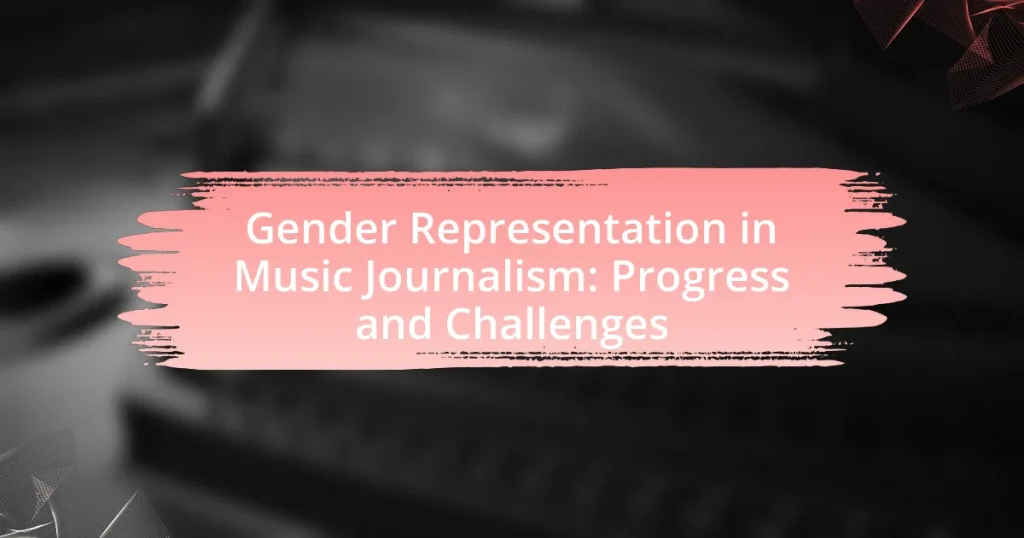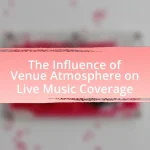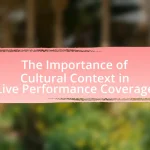Gender representation in music journalism refers to the inclusion and portrayal of various genders within music writing and criticism, highlighting a historical male dominance in the field. Currently, women constitute approximately 30% of music journalists, yet significant disparities persist, particularly affecting female artists and non-binary individuals. The article examines the importance of gender representation, the historical context influencing it, current trends, and the challenges that remain in achieving equality. It also discusses the impact of gender biases on music genre perceptions and the evolving role of female journalists, while outlining strategies and initiatives aimed at promoting gender equity in music journalism.
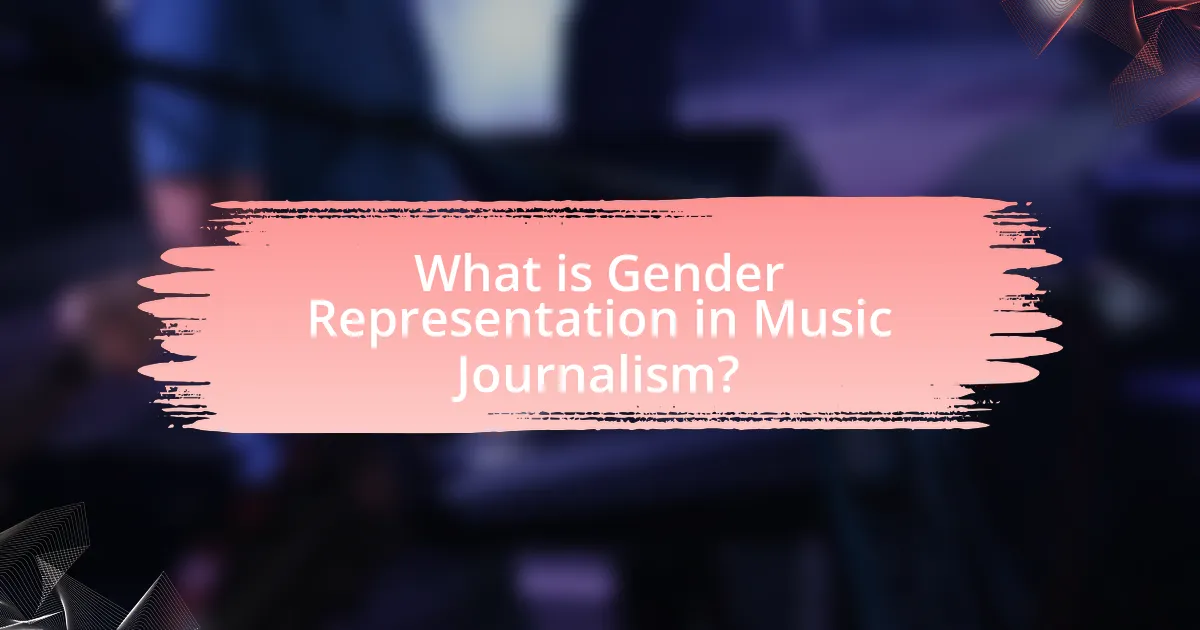
What is Gender Representation in Music Journalism?
Gender representation in music journalism refers to the portrayal and inclusion of different genders within music writing and criticism. Historically, music journalism has been male-dominated, with women and non-binary individuals often underrepresented in both the creation of content and the subjects covered. Research indicates that women make up only about 20% of music critics in major publications, highlighting a significant gender imbalance. This lack of representation can perpetuate stereotypes and limit the diversity of voices and perspectives in music discourse.
Why is gender representation important in music journalism?
Gender representation is important in music journalism because it ensures diverse perspectives and equitable coverage of artists, which reflects the true landscape of the music industry. A study by the Annenberg Inclusion Initiative found that only 22.4% of artists in popular music were women from 2012 to 2019, highlighting a significant gender disparity. This lack of representation can lead to biased narratives and the marginalization of female artists, ultimately affecting their visibility and opportunities within the industry. By promoting gender diversity in music journalism, the industry can foster a more inclusive environment that accurately represents the contributions of all artists.
What historical context influences gender representation in music journalism?
Historical context influencing gender representation in music journalism includes the evolution of societal attitudes towards women, particularly during the feminist movements of the 1960s and 1970s, which challenged traditional gender roles. This period saw an increase in women’s participation in various fields, including journalism, leading to a gradual shift in how female artists and writers were perceived and represented. For instance, the rise of female rock journalists, such as Ellen Willis and Lisa Robinson, helped to bring attention to women’s perspectives in music criticism, countering the male-dominated narratives prevalent in earlier decades. Additionally, the backlash against sexism in the music industry during the 1990s, exemplified by the emergence of Riot Grrrl and other feminist music movements, further influenced the representation of women in music journalism, pushing for more equitable coverage and recognition of female artists.
How does gender representation impact the perception of music genres?
Gender representation significantly impacts the perception of music genres by shaping audience expectations and influencing genre associations. For instance, research indicates that genres traditionally dominated by male artists, such as rock and hip-hop, are often perceived as more credible and serious, while genres with higher female representation, like pop and country, may be viewed as less authentic or serious. A study by the Annenberg Inclusion Initiative found that only 22.4% of popular songs from 2012 to 2019 featured female artists, highlighting the gender disparity in representation. This underrepresentation can lead to stereotypes that affect how audiences engage with and value different music genres, reinforcing biases that favor male artists and diminishing the perceived legitimacy of female artists in various genres.
What are the current trends in gender representation within music journalism?
Current trends in gender representation within music journalism indicate a gradual increase in the visibility and influence of women and non-binary individuals. Research shows that women now contribute to approximately 30% of music journalism, a notable rise from previous decades when their representation was significantly lower. Additionally, platforms and publications are increasingly prioritizing diverse voices, leading to a broader range of perspectives in music criticism and reporting. This shift is supported by initiatives aimed at promoting gender equity in media, such as mentorship programs and diversity quotas in editorial teams.
How has the role of female journalists evolved in the music industry?
The role of female journalists in the music industry has evolved significantly from being marginalized to becoming influential voices in shaping music narratives. Historically, female journalists faced barriers to entry and were often relegated to covering specific genres or events, but over the past few decades, there has been a notable increase in their representation and impact. For instance, the rise of digital media has provided platforms for female journalists to showcase their work, leading to greater visibility and recognition. According to a 2020 study by the Annenberg Inclusion Initiative, women made up 23.3% of music journalists, a figure that reflects gradual progress compared to previous decades. This evolution has allowed female journalists to challenge stereotypes, advocate for diversity, and contribute to a more inclusive music discourse.
What statistics reflect gender representation in music journalism today?
As of 2023, statistics indicate that women represent approximately 30% of music journalists, highlighting a significant gender disparity in the field. A study conducted by the Music Journalism Coalition found that only 22% of music reviews in major publications were written by women, underscoring the underrepresentation of female voices in music criticism. Furthermore, a report from the Annenberg Inclusion Initiative revealed that women of color are particularly marginalized, comprising less than 10% of music journalists. These statistics reflect ongoing challenges in achieving gender equity within music journalism.
What challenges persist in achieving gender equality in music journalism?
Challenges that persist in achieving gender equality in music journalism include systemic biases, underrepresentation of women, and a lack of equitable opportunities. Systemic biases manifest in hiring practices and editorial decisions that favor male voices, leading to a significant gender imbalance; for instance, a study by the Annenberg Inclusion Initiative found that only 22% of music journalists are women. Underrepresentation is evident in the coverage of female artists, who often receive less media attention compared to their male counterparts, further perpetuating stereotypes and limiting visibility. Additionally, women in music journalism frequently encounter barriers to career advancement, such as fewer networking opportunities and mentorship, which hinders their professional growth and influence in the industry.
What barriers do women face in entering music journalism?
Women face significant barriers in entering music journalism, including gender bias, lack of representation, and limited access to networking opportunities. Gender bias manifests in the form of stereotypes that question women’s expertise and authority in music, often leading to their work being undervalued compared to their male counterparts. The lack of representation in editorial positions further exacerbates this issue, as fewer women in leadership roles can result in a lack of mentorship and support for aspiring female journalists. Additionally, limited access to networking opportunities, often dominated by male-centric environments, restricts women’s ability to build professional connections essential for career advancement. These barriers contribute to the underrepresentation of women in music journalism, highlighting the need for systemic change within the industry.
How do biases affect the coverage of female artists in music journalism?
Biases significantly affect the coverage of female artists in music journalism by perpetuating stereotypes and limiting visibility. Research indicates that female artists often receive less media attention compared to their male counterparts, with a study by the Annenberg Inclusion Initiative revealing that only 22.4% of artists in popular music are women. This disparity is compounded by biases that prioritize male narratives and achievements, leading to a skewed representation that undermines the contributions of female musicians. Furthermore, female artists are frequently subjected to gendered critiques that focus on appearance rather than musical talent, which further diminishes their professional credibility in the industry.
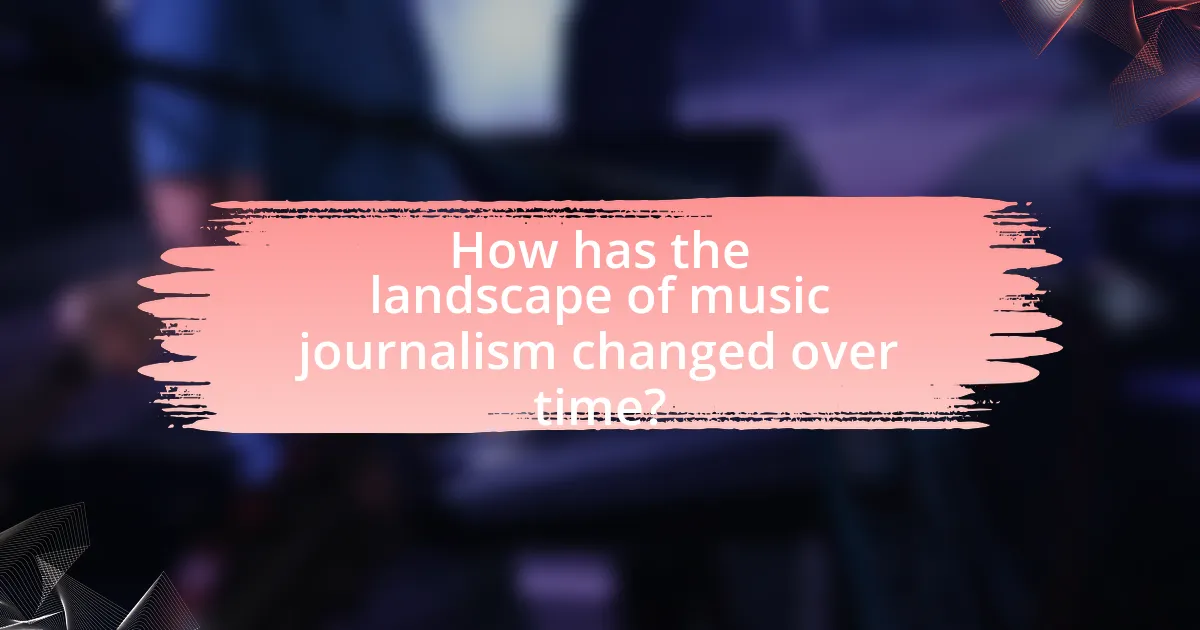
How has the landscape of music journalism changed over time?
The landscape of music journalism has evolved significantly from print-centric platforms to digital and social media-driven formats. Historically, music journalism was dominated by male voices in print magazines and newspapers, which often marginalized female artists and perspectives. With the rise of the internet and social media, diverse voices have gained prominence, allowing for greater representation of women and underrepresented groups in music journalism. For instance, platforms like Pitchfork and online blogs have provided space for female critics and writers, contributing to a more inclusive discourse. This shift is evidenced by the increasing number of women in editorial positions and the growing visibility of female artists in music critiques, reflecting broader societal changes towards gender equality.
What historical milestones have shaped gender representation in music journalism?
Historical milestones that have shaped gender representation in music journalism include the emergence of women writers in the 1960s and 1970s, such as Ellen Willis and Lisa Robinson, who challenged male-dominated narratives. The feminist movements of the 1970s further propelled women’s voices in music criticism, leading to the establishment of publications like “Rock She Wrote” in 1995, which specifically focused on women’s perspectives in music. Additionally, the rise of digital media in the 2000s allowed for greater diversity in voices, enabling more women to contribute to music journalism. These milestones collectively reflect a gradual shift towards more inclusive gender representation in the field.
How did the feminist movements influence music journalism?
Feminist movements significantly influenced music journalism by advocating for gender equality and challenging the male-dominated narratives within the industry. These movements prompted a critical examination of how women artists were represented, leading to increased visibility and coverage of female musicians. For instance, the rise of feminist music criticism in the 1970s and 1980s, exemplified by publications like “Sister Outsider” by Audre Lorde, emphasized the importance of diverse voices and perspectives in music discourse. This shift resulted in a more inclusive approach to music journalism, where issues of sexism, representation, and the experiences of women in music became central topics of discussion.
What role did technology play in changing music journalism practices?
Technology significantly transformed music journalism practices by enabling instant access to information and facilitating diverse content creation. The rise of the internet and social media platforms allowed journalists to share articles, reviews, and interviews in real-time, reaching wider audiences than traditional print media could. For instance, platforms like Twitter and Instagram have become essential tools for music journalists to engage with fans and artists directly, fostering a more interactive and immediate form of journalism. Additionally, the availability of digital tools for audio and video editing has empowered journalists to produce multimedia content, enhancing storytelling and audience engagement. This shift has also democratized music journalism, allowing independent voices and underrepresented perspectives, particularly from marginalized genders, to gain visibility in the industry.
What are the implications of gender representation on music journalism’s future?
Gender representation significantly influences the future of music journalism by shaping narratives, diversifying perspectives, and impacting audience engagement. A balanced representation can lead to more inclusive storytelling, which reflects the diverse experiences of artists and listeners alike. Research indicates that when women and non-binary individuals are represented in music journalism, it fosters a broader understanding of genres and cultural contexts, ultimately enriching the discourse within the industry. For instance, a study by the Annenberg Inclusion Initiative found that only 22.5% of music journalists are women, highlighting the need for increased representation to ensure varied viewpoints are heard. This shift not only enhances the credibility of music journalism but also attracts a wider audience, as diverse voices resonate with different demographics.
How can music journalism adapt to promote better gender representation?
Music journalism can adapt to promote better gender representation by actively prioritizing the coverage of female artists and gender-diverse musicians. This can be achieved through initiatives such as implementing gender quotas for featured artists in articles, reviews, and interviews, ensuring that at least 50% of the content highlights women and non-binary individuals in the music industry. Research from the Annenberg Inclusion Initiative indicates that only 22% of artists in popular music are women, highlighting the need for a more balanced representation. Additionally, music publications can diversify their editorial teams to include more women and gender-diverse voices, which can lead to a broader range of perspectives and stories being told. By committing to these practices, music journalism can create a more equitable platform that reflects the diversity of the music landscape.
What initiatives are being taken to support gender equality in music journalism?
Initiatives to support gender equality in music journalism include mentorship programs, diversity hiring practices, and advocacy groups focused on women’s representation. Organizations like Women in Music and the Music Journalism Coalition actively promote these initiatives by providing resources, networking opportunities, and training specifically aimed at women in the field. Additionally, studies have shown that increasing the number of women in editorial positions leads to more balanced coverage of female artists, thereby enhancing gender representation in music journalism.
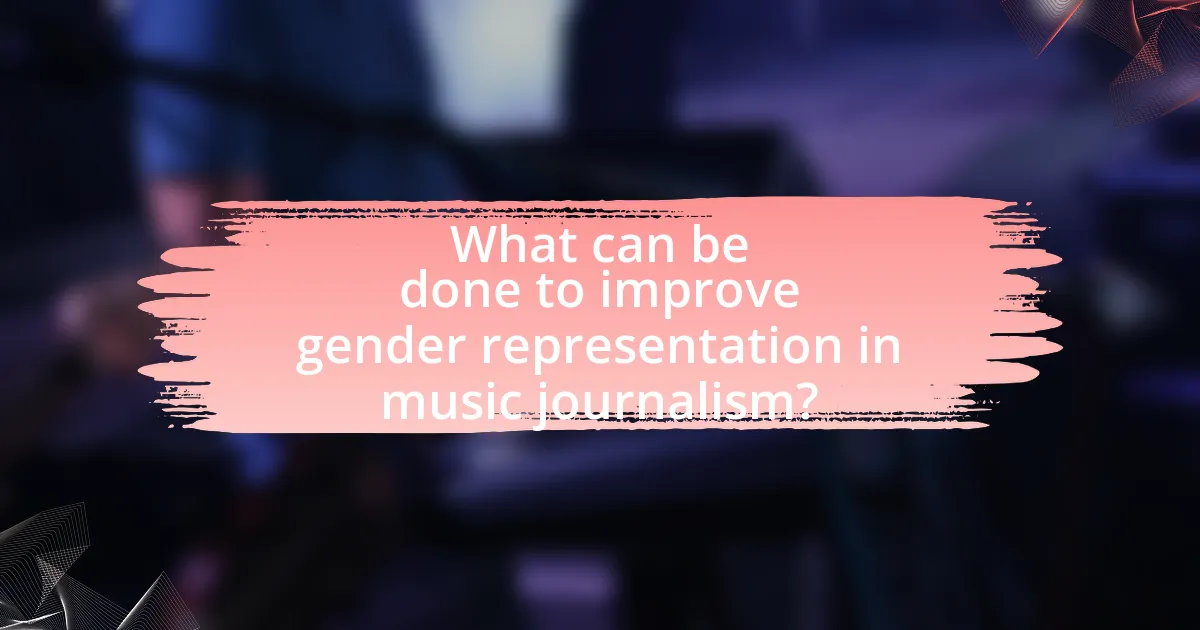
What can be done to improve gender representation in music journalism?
To improve gender representation in music journalism, media organizations should implement targeted hiring practices that prioritize diversity. Research indicates that diverse teams produce more comprehensive and varied content, which can enhance audience engagement and representation. For instance, a study by the Annenberg Inclusion Initiative found that women are underrepresented in music journalism, comprising only 20% of bylines in major publications. By actively recruiting female journalists and providing mentorship programs, organizations can create a more balanced workforce. Additionally, promoting female voices through dedicated features and panels can further elevate gender representation in the field.
What strategies can organizations implement to promote gender equality?
Organizations can implement strategies such as establishing clear diversity and inclusion policies, providing bias training, and promoting mentorship programs to promote gender equality. Clear policies set expectations for equitable practices, while bias training helps employees recognize and mitigate unconscious biases that affect decision-making. Mentorship programs can empower women by connecting them with experienced professionals who can guide their career development. According to a McKinsey report, companies with diverse leadership teams are 21% more likely to outperform their peers in profitability, highlighting the effectiveness of these strategies in fostering an inclusive workplace.
How can mentorship programs support aspiring female music journalists?
Mentorship programs can support aspiring female music journalists by providing guidance, networking opportunities, and industry insights. These programs connect emerging journalists with experienced professionals who can share valuable knowledge about navigating the music industry, enhancing writing skills, and understanding the nuances of music criticism. Research indicates that mentorship significantly boosts career advancement; for instance, a study by the American Psychological Association found that mentees are more likely to receive promotions and salary increases. Additionally, mentorship fosters a sense of community and belonging, which is crucial in a field where female representation has historically been low. By facilitating these connections, mentorship programs empower aspiring female journalists to overcome barriers and succeed in their careers.
What role do media outlets play in fostering gender diversity?
Media outlets play a crucial role in fostering gender diversity by shaping public narratives and providing platforms for diverse voices. They influence societal perceptions of gender roles through the representation of women and non-binary individuals in music journalism, which can challenge stereotypes and promote inclusivity. For instance, studies have shown that increased visibility of female artists in media coverage correlates with greater acceptance and support for gender diversity in the music industry. By prioritizing equitable representation in their content, media outlets can actively contribute to a more balanced and diverse cultural landscape.
What best practices can individual journalists adopt to enhance gender representation?
Individual journalists can enhance gender representation by actively seeking diverse voices and perspectives in their reporting. This involves prioritizing interviews and features with women and non-binary individuals, ensuring that their stories and contributions are highlighted in music journalism. Research indicates that media representation significantly influences public perception; for instance, a study by the Geena Davis Institute on Gender in Media found that female characters in media are often underrepresented, which can perpetuate stereotypes. By consciously including a broader range of gender identities in their work, journalists can contribute to a more equitable media landscape and challenge existing biases.
How can journalists ensure balanced coverage of male and female artists?
Journalists can ensure balanced coverage of male and female artists by actively seeking to feature an equal number of both genders in their articles and reviews. This can be achieved by implementing a systematic approach to artist selection, where journalists maintain a diverse roster of artists to cover, reflecting the gender distribution in the music industry. Research indicates that women are often underrepresented in music journalism, with studies showing that only 20% of music reviews feature female artists. By consciously prioritizing female artists and promoting their work, journalists can help rectify this imbalance and provide a more equitable representation in the media.
What resources are available for journalists to educate themselves on gender issues?
Journalists can access various resources to educate themselves on gender issues, including online courses, workshops, and publications. Notable platforms such as the Poynter Institute offer courses specifically focused on gender reporting, while organizations like the International Women’s Media Foundation provide workshops and resources aimed at enhancing gender sensitivity in journalism. Additionally, publications such as “Gender and Media: A Handbook” by Karen Ross and “The Gendered Society” by Michael Kimmel serve as valuable texts for understanding gender dynamics. These resources are designed to equip journalists with the knowledge and skills necessary to report on gender issues accurately and sensitively.
What are the key takeaways for fostering gender representation in music journalism?
Key takeaways for fostering gender representation in music journalism include promoting diverse hiring practices, ensuring equitable opportunities for women and non-binary individuals, and actively challenging gender biases in coverage. Research indicates that women make up only 16% of music critics, highlighting the need for systemic changes in hiring and editorial policies. Additionally, initiatives such as mentorship programs and workshops can empower underrepresented voices, fostering a more inclusive environment. By implementing these strategies, the music journalism industry can enhance gender representation and create a more balanced narrative in music coverage.
